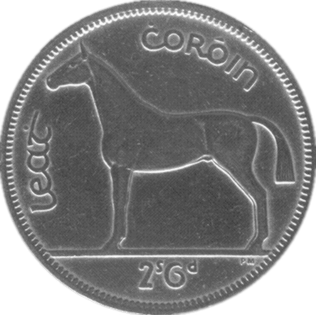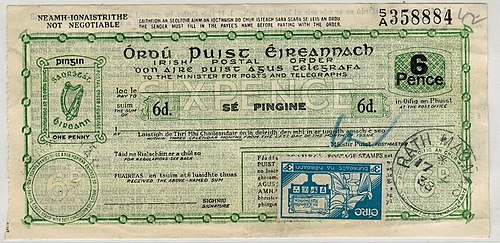
An overprint is an additional layer of text or graphics added to the face of a postage or revenue stamp, postal stationery, banknote or ticket after it has been printed. Post offices most often use overprints for internal administrative purposes such as accounting but they are also employed in public mail. Well-recognized varieties include commemorative overprints which are produced for their public appeal and command significant interest in the field of philately.

This is an introduction to the postal and philatelic history of Italy.
The Straits Settlements of the Malayan Peninsula have a postal history distinct from the other Malayan areas.

The penny (1d) coin was the third-smallest denomination of the pre-decimal Irish pound, worth 1⁄240 of a pound or 1⁄12 of a shilling. To express an amount, penny was abbreviated to "d", e.g. 1d, from the Roman denarius. It was introduced in 1928 to replace its British counterpart, used when all of Ireland was a constituent country of the United Kingdom. The last year of minting was 1968 and it ceased to be legal tender on 31 December 1971.

The half crown coin was a subdivision of the pre-decimal Irish pound, worth 1⁄8 of a pound. The half crown was commonly called "two and six" due to its value of two shillings and sixpence.
The Irish Free State, subsequently known as Ireland, resolved in the mid-1920s to design its own coins and banknotes. Upon issuing the new currency, the Free State government pegged its value to the pound sterling. The Currency Act, 1927 was passed as a basis for creating banknotes and the "Saorstát pound" as the "standard unit of value." The legal tender notes issued under this act began circulating on 10 September 1928.

A postal order or postal note is a type of money order usually intended for sending money through the mail. It is purchased at a post office and is payable to the named recipient at another post office. A fee for the service, known as poundage, is paid by the purchaser. In the United States, this is known as a postal money order. Postal orders are not legal tender, but a type of promissory note, similar to a cheque.
Each "article" in this category is in fact a collection of entries about several stamp issuers, presented in alphabetical order. The entries themselves are formulated on the micro model and so provide summary information about all known issuers.

The British post offices in Morocco, also known as the "Morocco Agencies", were a system of post offices operated by Gibraltar and later the United Kingdom in Morocco.
The Series A banknotes are considered to "count amongst the most iconic and beautiful of all modern banknotes." They were the first banknotes created by and for the Irish Free State in 1928 and continued to be issued when the Free State became Ireland. The series is known as "The Lady Lavery Series", from the prominent portrait on the front of the notes. The notes were issued from 1928 to 1977 until they were gradually replaced by Series B banknotes beginning in 1976. However, as no £100 note was issued in Series B, the Series A £100 note remained in use until replaced by the Series C note in 1996.
Postal orders were a service provided by the Canadian Post Office, and was a method of transferring funds between 1898 and 1 April 1949.
Postal orders of the Orange Free State were introduced on 1 January 1898. They came in a range of denominations from 1 Shilling to 1 Pond. The Orange Free State's postal orders were known in Dutch spelling - 'ORANJE VRIJ STAAT', which also appears in the watermark.

The postage stamps of Ireland are issued by the postal operator of the independent Irish state. Ireland was part of the United Kingdom of Great Britain and Ireland when the world's first postage stamps were issued in 1840. These stamps, and all subsequent British issues, were used in Ireland until the new Irish Government assumed power in 1922. Beginning on 17 February 1922, existing British stamps were overprinted with Irish text to provide some definitives until separate Irish issues became available. Following the overprints, a regular series of definitive stamps was produced by the new Department of Posts and Telegraphs, using domestic designs. These definitives were issued on 6 December 1922; the first was a 2d stamp, depicting a map of Ireland. Since then new images, and additional values as needed, have produced nine definitive series of different designs.

Postage stamps and postal history of the Canal Zone is a subject that covers the postal system, postage stamps used and mail sent to and from the Panama Canal Zone from 1904 up until October 1978, after the United States relinquished its authority of the Zone in compliance with the treaty it reached with Panama.
Postal orders were issued in South Africa from 31 May 1910. South Africa issued both its own postal orders and British postal orders.

The German post offices abroad were a network of post offices in foreign countries established by Germany to provide mail service where the local services were deemed unsafe or unreliable. They were generally set up in cities with some sort of German commercial interest. In early use only the cancellation mark can identify their postal use abroad; such stamps are known as "Vorläufer" (forerunner) stamps. Later stamps are identified by overprints even when not postally used. German abroad stamps started appearing in the late 19th century and reached their heyday at the beginning of the 20th century; they closed down during or shortly after World War I.
Admirals are a series of definitive stamps issued by three countries of the British Commonwealth that show King George V of Great Britain and the British Dominions. The stamps are referred to as the Admirals because King George is depicted in his Admiral of the Fleet uniform. The stamps were issued by Canada in 1911–1928, New Zealand in 1926, and Rhodesia in 1913–24.

This is a survey of postage stamps and postal history of the German colonies and part of the postage stamps and postal history of Germany, as well as those of the individual countries and territories concerned.

This is a survey of the postage stamps and postal history of Gibraltar.

New Zealand first issued revenue stamps on 1 January 1867 and their general use continued until the early 1950s. The only Revenue Stamp series still in use today is the Game Bird Habitat stamp which is used for payment of the Gun License for the duck shooting season which begins the first weekend of May. There were various types of fiscal stamps for different taxes.


















